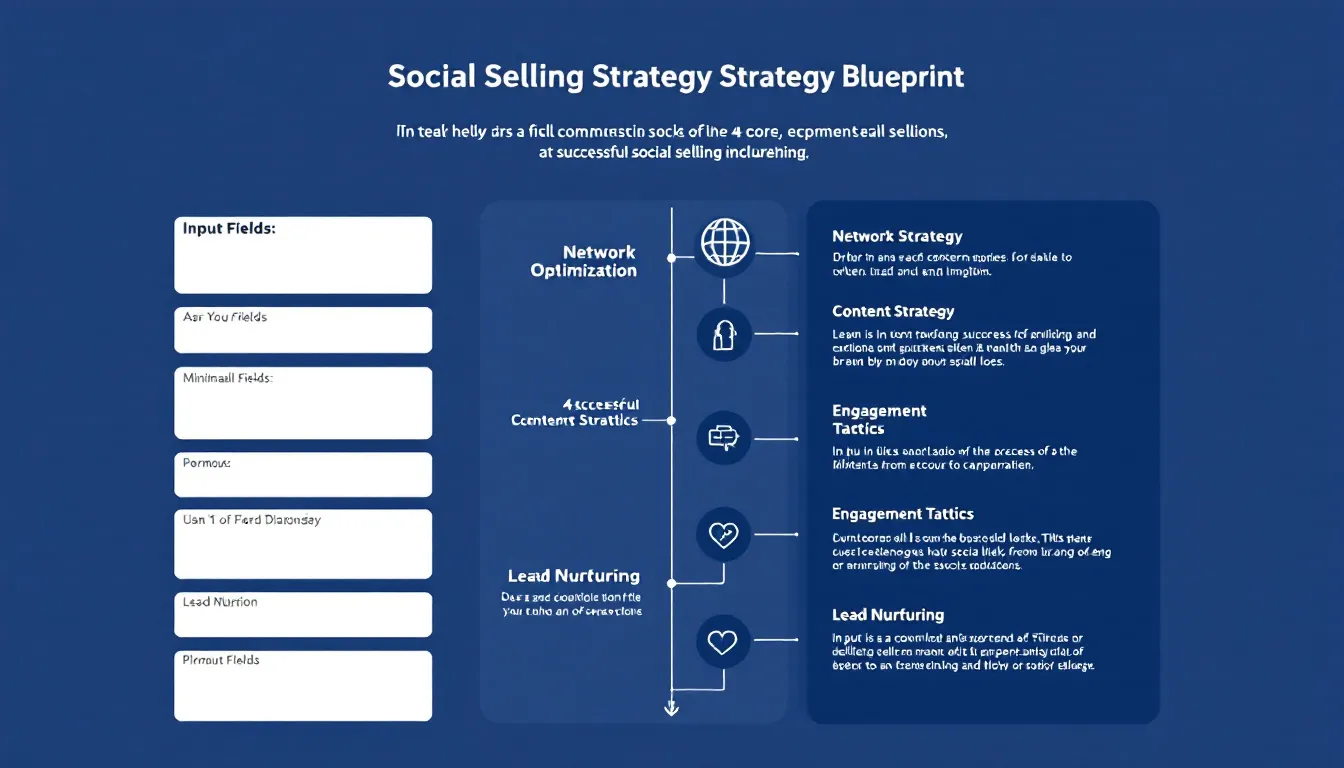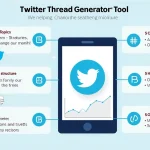Is this tool helpful?
How to Use the Social Selling Strategy Generator Effectively
The Social Selling Strategy Generator is designed to create customized strategies for businesses looking to leverage their team’s professional networks for sales growth. Here’s a detailed guide on how to use each field effectively:
1. Company Name Field
Enter your company’s official name. For example:
- “Global Analytics Partners” – A data analytics consulting firm
- “Eco-Smart Solutions” – An environmental technology company
2. Products/Services Description
Provide a comprehensive description of your offerings, focusing on unique value propositions. Examples:
- “We offer AI-powered predictive maintenance solutions for industrial equipment, reducing downtime by up to 40%”
- “Our sustainable packaging alternatives help restaurants reduce plastic waste while maintaining food freshness”
3. Target Audience Description
Detail your ideal customer profile with specific characteristics:
- “Industrial facility managers in Fortune 500 companies with 500+ employees and $100M+ annual revenue”
- “Independent restaurant owners in metropolitan areas with 2+ locations and focus on sustainable practices”
4. Pain Points Field
List specific challenges your target audience faces:
- “High maintenance costs, unexpected equipment failures, limited predictive capabilities”
- “Rising costs of traditional packaging, customer demand for eco-friendly options, storage space limitations”
5. Optional Fields
Complete these for more tailored results:
- Team Size: Enter the number of employees who will participate in social selling
- Platform: Specify your preferred social network (e.g., LinkedIn, Twitter)
Understanding Social Selling Strategy Generation
Social selling has transformed the traditional sales landscape by leveraging social networks to build stronger relationships with prospects. This tool creates customized strategies that align your team’s social presence with your business objectives.
Core Components of Social Selling Success
- Network Optimization
- Content Strategy
- Engagement Tactics
- Lead Nurturing Processes
Benefits of Using the Social Selling Strategy Generator
1. Time Efficiency
Instead of spending weeks developing a strategy manually, receive a comprehensive plan in minutes.
2. Customization
Get tailored recommendations based on your specific:
- Industry context
- Target audience characteristics
- Team capabilities
- Product/service offerings
3. Scalability
Generate strategies that can be implemented across teams of any size, from individual salespeople to enterprise sales forces.
Strategic Implementation and Problem-Solving
Addressing Common Challenges
The generator creates solutions for typical social selling obstacles:
1. Network Expansion
- Identifying key decision-makers
- Creating meaningful connections
- Leveraging second-degree connections
2. Content Planning
- Topic selection
- Posting frequency
- Content mix optimization
3. Engagement Optimization
- Response timing
- Conversation starters
- Value-added interactions
Practical Applications and Use Cases
Example 1: Technology Services Company
Input:
- Company: CloudTech Solutions
- Service: Cloud migration services
- Target: Mid-sized enterprises
- Pain Points: Legacy system challenges
Strategy Output:
- LinkedIn-focused approach
- Technical content sharing
- Case study distribution
- IT director targeting
Example 2: Professional Services Firm
Input:
- Company: Elite Consulting Group
- Service: Management consulting
- Target: C-suite executives
- Pain Points: Organizational efficiency
Strategy Output:
- Executive networking approach
- Thought leadership content
- Industry insight sharing
- Strategic partnership building
Frequently Asked Questions
What is social selling?
Social selling is the practice of using social media networks to find, connect with, understand, and nurture sales prospects. It’s the modern way of building meaningful relationships with potential customers.
How long should I wait before seeing results?
Social selling is a relationship-building process that typically shows initial engagement within 30-90 days, with significant results appearing within 6-12 months of consistent implementation.
Which social platform is best for B2B social selling?
LinkedIn is generally considered the most effective platform for B2B social selling, though the ideal platform depends on your specific industry and target audience.
How many team members should be involved in social selling?
The optimal number varies based on organization size, but starting with a core team of 3-5 members allows for effective coordination while maintaining consistent quality.
Should I focus on multiple social platforms simultaneously?
It’s recommended to master one platform before expanding to others. This approach ensures quality engagement and efficient resource utilization.
How often should team members post content?
A consistent schedule of 3-5 high-quality posts per week is typically more effective than frequent, lower-quality content.
Can social selling replace traditional sales methods?
Social selling should complement rather than replace traditional sales methods, creating an integrated approach to modern sales engagement.
What type of content works best for social selling?
A mix of educational content (40%), industry insights (30%), and company-specific information (30%) typically yields the best engagement results.
How do I measure social selling success?
Key metrics include Social Selling Index (SSI), engagement rates, connection growth, and ultimately, pipeline growth and conversion rates.
Is social selling effective for all industries?
Yes, though the approach and platforms may vary. The key is adapting the strategy to your specific industry’s communication norms and buyer behaviors.
Important Disclaimer
The calculations, results, and content provided by our tools are not guaranteed to be accurate, complete, or reliable. Users are responsible for verifying and interpreting the results. Our content and tools may contain errors, biases, or inconsistencies. We reserve the right to save inputs and outputs from our tools for the purposes of error debugging, bias identification, and performance improvement. External companies providing AI models used in our tools may also save and process data in accordance with their own policies. By using our tools, you consent to this data collection and processing. We reserve the right to limit the usage of our tools based on current usability factors. By using our tools, you acknowledge that you have read, understood, and agreed to this disclaimer. You accept the inherent risks and limitations associated with the use of our tools and services.







